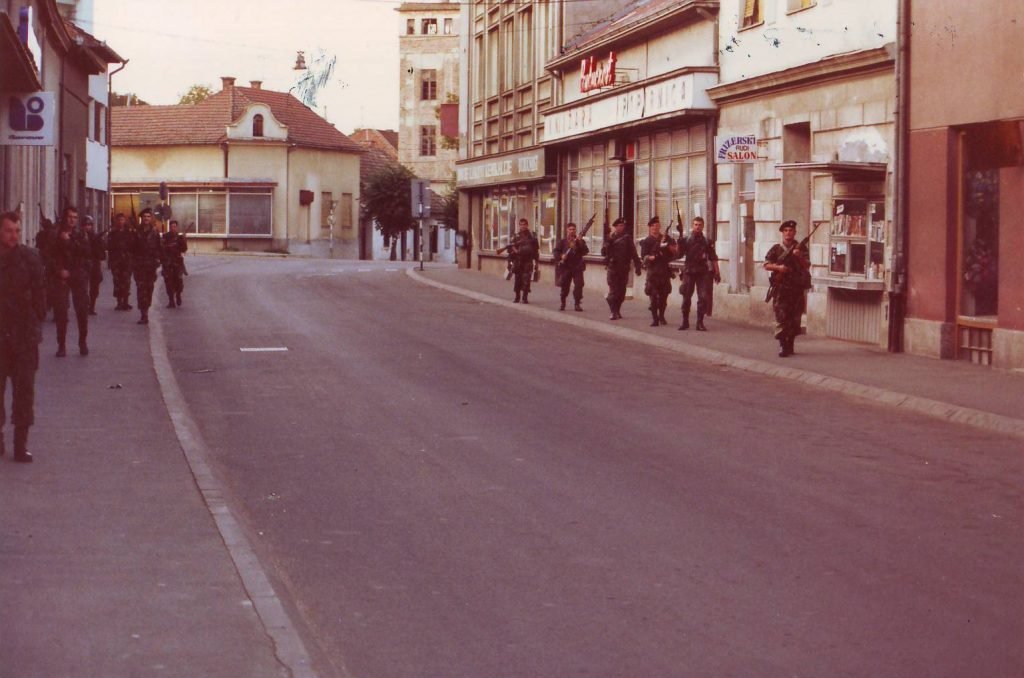On this day, 19 August 1991 rebel Serbs attacked Pakrac, Lipik and Daruvar.
The situation in the area had been extremely tense since 1 March 1991 when Serb police officers conducted a coup at the Pakrac police station. Croatian forces regained control of the station the next day and this event is considered by many to be the beginning of the Homeland War.
Open conflict was unavoidable once the first casualty in Pakrac took place on 9 June and the killings of three Croatian policemen in the center of Daruvar in July further indicated in which direction the conflict was headed. As early as 17 August 1991 most Serb families left Pakrac in the direction of occupied territory and the next day Dr. Ivan Šreter, Director of the Lipik hospital, President of the Croatian Democratic Union (CDU) in Pakrac and a prominent advocate for the peaceful resolution of existing tensions was captured at Serbian barricades and taken to an unknown location.
Daruvar was attacked first at approximately 3:00 AM on 19 August as insurgent Serbs launched an infantry and mortar assault upon the narrowest point of the city where the bus and train station as well as the city market were located. Although they failed to occupy the police station (their intended target), the Serbs captured five police officers. One was released soon afterwards and another allegedly sided with the aggressor but the fates of Damir Rambousek, Darko Petrovicki and Marijan Petrovečki are unknown and their remains yet to be located. They were most likely taken to the village of Bijela near Daruvar or the Bučje camp where they were tortured and killed. One of those suspected of kidnapping the officers was arrested by the Croatian police at a border crossing with Serbia in 2010 but any hopes that the families had of finding their loved ones were dashed when the accused acquitted in the Bjelovar County Court that same year.
The assault on Daruvar was followed by a heavy mortar attack on Pakrac at approximately 5:00 AM. A ground offensive to gain control of the police station was then launched at 7:00 AM in which Serb insurgents even used anti-tank weapons. Some residents who were mostly from Prekopakra and armed with hunting and trophy weapons tried to break through to the besieged police officers. Although their firepower was weak, they managed to slow down the advance of the enemy by cleverly transferring weapons from point to point thus creating the appearance of a well-equipped force.
Police officers in the besieged station also managed to deceive the attackers by reporting that several hundred armed “special forces” were coming from Daruvar and Kutina. Despite their superior numbers and firepower, Serb rebels failed to occupy the police station. However, they unfortunately took control of the hospital and took its Director, Dr. Vladimir Solar, into custody. He was returned to Croatian authorities following a prisoner exchange in 1992.
Special forces units from Kutina, Zagreb and Bjelovar arrived in Pakrac in the evening. The special police unit “Ris” from Kutina cleared the southern and southwestern parts of the city and liberated the hospital while the Anti-Terrorist Unit (ATU) “Lučko” from Zagreb and the Special Police Unit “Omega” from Bjelovar entered Pakrac together from Prekopakra. Enemy troops fired at them from various buildings in the city and the main attack originated from the Pakrac vineyards and Gavrinica. The “special forces” managed to repel the rebels and force them to retreat to their initial positions outside of the city following heavy street fighting. Some troops from the “special forces” also attacked the police station as it was reported that members of the “Martićevci” or “SAR Krajina militia” were in the building. Fortunately, the attack stopped without casualties when the Croatian flag was raised at the station.

It is necessary to mention that a mortar attack was launched upon Lipik that same day. Among the first facilities affected was the “Lipik Children’s Home” which had about 80 children aged 3 to 16 as residents. As the barrage took place early in the morning when the children were asleep, they awoke and fled to the basement where they spent 7 days before they were finally evacuated.
The battles for these three cities continued through the beginning of 1992 when a truce was signed between the Yugoslav People’s Army (YPA) the Croatian Army. While Croatian forces in Daruvar managed to push the rebel Serbs and the YPA beyond its suburbs, Pakrac and Lipik were not so lucky. These two cities suffered considerable destruction due to heavy street fighting and Lipik was completely occupied for some time. After the armistice came into effect, part of Pakrac stayed in enemy hands and remained a hotbed of crisis until that part of Croatia was finally liberated following operation “FLASH” in May of 1995.
Cover photo
Members of the Special Police Unit “Omega” Bjelovar are advancing towards Pakrac (photo by Robert Belošević)
Sources
Literature
Runtić, Davor. Junaci Domovinskog rata (knjiga 11). Vinkovci – Šibenik: Neobična naklada, 2006.
Internet
“Zločin u Bijeloj”, Documenta, accessed on August 19, 2020, https://www.documenta.hr/hr/zlo%C4%8Din-u-bijeloj.html
Ivan Zvonimir Ivančić: “Opći napad na Pakrac – 19. kolovoza 1991. godine”, Braniteljski.hr, accessed on August 19, 2020, https://braniteljski.hr/opci-napad-na-pakrac-19-kolovoza-1991-godine/
Darko Žubrinić: “Dječji dom Lipik i pukovnik Mark Cook”, croatianhistory.net, accessed on August 19, 2020, http://www.croatianhistory.net/etf/lipikh.html
Graduated with a Master’s Degree in History from the University of Zagreb. He has worked at the Croatian History Museum and as a researcher for the popular TV Calendar program for Croatian Radio and Television. He has authored several books and documentaries about Croatia’s Homeland War and is the creator/producer of the immensely popular “It Happened on this Day – Homeland War” Facebook page as well as the online portal Domovinskirat.hr. Borna also is the host and editor of the daily segment “Patriotic Minutes” on Croatian Catholic Radio. He created CroHis to promote the values of the Homeland War and ensure that the sacrifices of those who defended Croatia’s independence would not be forgotten.

